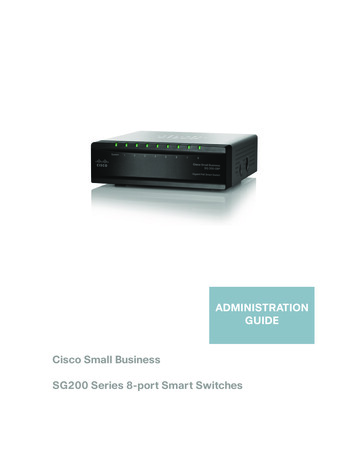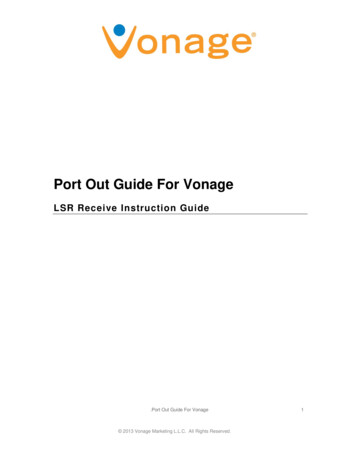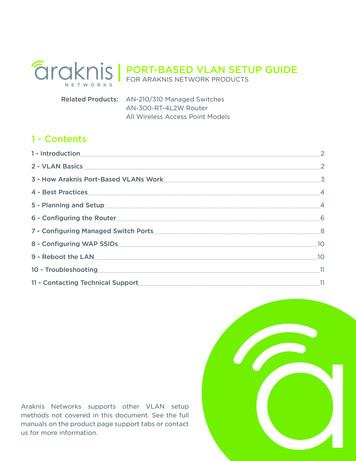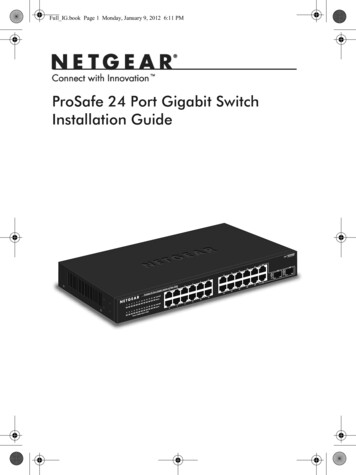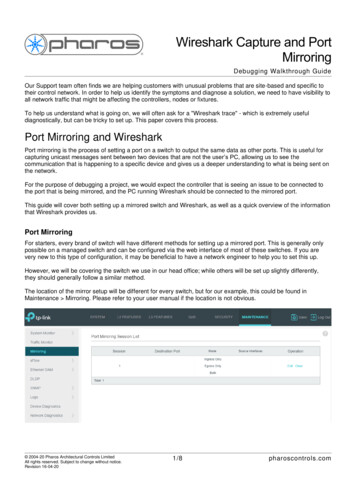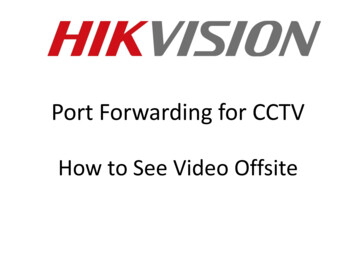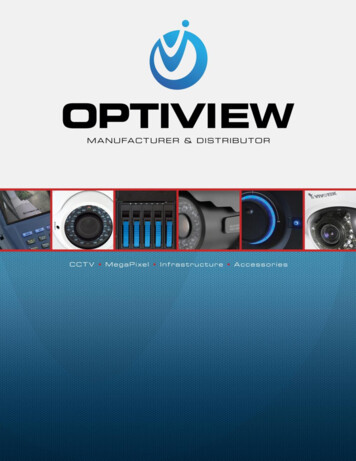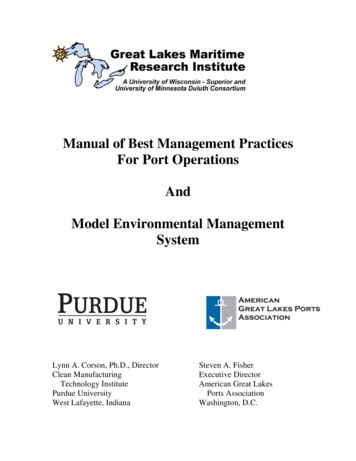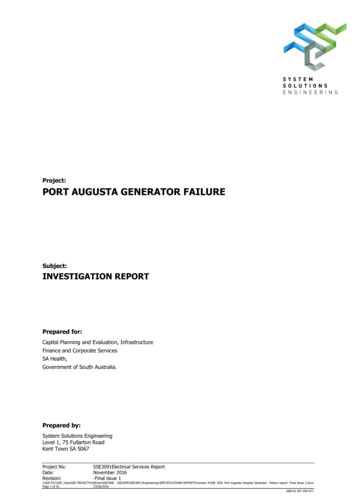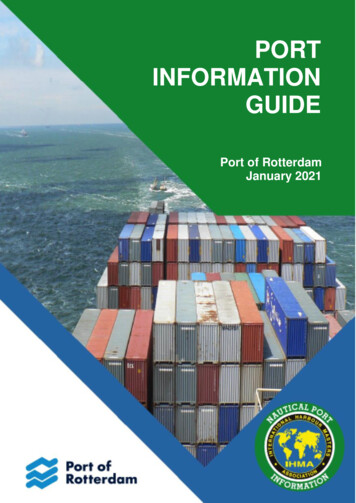
Transcription
PORTINFORMATIONGUIDEPort of RotterdamJanuary 2021
Port Information Guide - Rotterdam Port AuthorityLegal disclaimerPort Information Guide - Rotterdam Port AuthorityPort of Rotterdam makes every effort to make and maintain thecontents of this document as up-to-date, accessible, error-free andcomplete as possible, but the correctness and completeness of thesecontents cannot be guaranteed. Port of Rotterdam accepts no liabilitywhatsoever for the occurrence and/or consequences of errors, faultsor incompleteness or any other omission in connection with theinformation provided by this document. In case of any discrepancies orinconsistencies between this document and the applicable legislation,including the port bye-laws, the latter will 1.222021-01-052021.332021-01-27AVANTI – January 27, 2021ChangePublic holidays updates, page4,5Cancellation of pilot service,page 20Websites for weather and tideRemarksNoneNoneNone2
Port Information Guide - Rotterdam Port AuthorityPORT GENERAL INFORMATIONGeneral informationThe port provides facilities for cargo handling, storage, and distribution. The port area alsoaccommodates an extensive industrial complex.Most major carriers include Rotterdam in their services. From this strategically located port, thecontainers destined for other European countries are then forwarded by feeder services, inlandvessels, railway or trucks.The size of the port’s industrial area and its position at the gateway of the European inland waterwaynetwork makes the port of Rotterdam ideally located for the transshipment of cargo. The port ofRotterdam is well equipped for handling bulk and general cargoes, coal and ores, crude oil,agricultural products, chemicals, containers, cars, fruit, and refrigerated cargoes.Facilities for ship repair, maintenance and storage are available. The port is never closed because ofice. Indeed, even in severe winters when drift ice is present in the river, the traffic of seagoing vesselscontinues uninterrupted.For more information on the port of Rotterdam, visit the ntsNo developments at this timeLocation Latitude: 51 54’N Longitude: 004 18’E Country Code: NL UN Location Code: RTM Location Description: Rotterdam is situated at the entrance of the Nieuwe WaterwegLimits descriptionThe nautical supervision of the Port of Rotterdam Authority covers the following areas: Eurogeul and Maasgeul channels, approach area and anchor areas Nieuwe Waterweg and Nieuwe Maas up to kilometre mark 991.5 Oude Maas up to kilometre mark 998 Dordrecht Zwijndrecht Papendrecht Schiedam Vlaardingen RotterdamAVANTI – January 27, 20213
Port Information Guide - Rotterdam Port AuthorityISPS level ISPS Security Level: 1 Qualifying Remarks: naLoad lineNorth Atlantic Winter Seasonal Zone IIWinter November 1 to March 31, Summer April 1 to October 31Maximum vessel sizes Maximum length: na Maximum beam: na Maximum draught: 22,55 meter Maximum air draught: na Supplementary information: naTime Zone Standard Time UTC / GMT 1 hr Daylight Saving /- hrs: 1 hr DST Start: Night of last Saturday on Sunday in March DST End: Night of last Saturday on Sunday in OctoberLocal holidays Name: New Year’s Day Start Date: 01/01/21 End Day: 01/01/21 Name: Good FridayStart Date: 02/04/21End Day: 02/04/21 Name: Easter Sunday / MondayStart Date: 04/04/21End Date: 05/04/21 Name: Kings dayStart Date: 27/04/21End Date: 27/04/21 Name: Liberation dayStart Date: 05/05/21End Date: 05/05/21 Name: Ascension DayStart Date: 13/05/21End Date: 13/05/21AVANTI – January 27, 20214
Port Information Guide - Rotterdam Port Authority Name: White Sunday and White MondayStart Date: 23/05/21End Date: 24/05/21 Name: Christmas Day, Boxing DayStart Date: 25/12/21End Date: 26/12/21Working hours Start Day: 09.00End Day: 17.00Week Day Start: MondayWeek Day End: FridayCargo Cargo Type: Dry bulk Weight of Goods: 88 Ton Supplementary Information: na Cargo Type: Wet bulkWeight of Goods: 202 TonSupplementary Information: na Cargo Type: ContainerWeight of Goods: 128 TonSupplementary Information: na Cargo Type: RoroWeight of Goods: 20Supplementary Information: naNautical Publications Name: Dover Strait Pilot Identifier: NP 28 Publisher: UKHO Name: Netherlands Coast PilotIdentifier: HP1Publisher: Hydrographer of the Royal Netherlands Navy at Den Haag Name: Tidal heights and currentsIdentifier: HP33Publisher: Hydrographer of the Royal Netherlands Navy at Den HaagAVANTI – January 27, 20215
Port Information Guide - Rotterdam Port AuthorityNautical electronic charts Name: Approaches to Europoort Identifier: NL400122 Publisher: Hydrographer of the Royal Netherlands Navy at Den Haag Name: Hoek van Holland to MaassluisIdentifier: NL500207Publisher: Hydrographer of the Royal Netherlands at Den Haag Name: Maassluis to RotterdamIdentifier: NL500208Publisher: Hydrographer of the Royal Netherlands Navy at Den Haag Name: Rotterdam to DordrechtIdentifier: NL50209APublisher: Hydrographer of the Royal Netherlands Navy at Den Haag Name: Dordrecht to MoerdijkIdentifier: NL50209BPublisher: Hydrographer of the Royal Netherlands Navy at Den HaagNautical paper charts Name: Hoek van Holland to Vlaardingen Identifier: Int. 1465 Publisher: Jointly by the Hydrographer of the Royal Netherlands Navy at Den Haag and by theHydrographer of the Navy at Taunton Name: Rotterdam, Nieuw Maas and Oude MaasIdentifier: Int. 1466Publisher: Jointly by the Hydrographer of the Royal Netherlands Navy at Den Haag and by theHydrographer of the Navy at Taunton Name: Krimpen a/d Lek to Moerdijk, Dordrecht to MoerdijjkIdentifier: Int. 1467Publisher: Jointly by the Hydrographer of the Royal Netherlands Navy at Den Haag and by theHydrographer of the Navy at TauntonShipping announcementsCan be obtained from http://www.pin-rotterdam.nl/AVANTI – January 27, 20216
Port Information Guide - Rotterdam Port AuthorityLegal disclaimerPort of Rotterdam makes every effort to make and maintain the contents of this document as up-todate, accessible, error-free and complete as possible, but the correctness and completeness of thesecontents cannot be guaranteed. Port of Rotterdam accepts no liability whatsoever for the occurrenceand/or consequences of errors, faults or incompleteness or any other omission in connection withthe information provided by this document. In case of any discrepancies or inconsistencies betweenthis document and the applicable legislation, including the port bye-laws, the latter will VANTI – January 27, 20217
Port Information Guide - Rotterdam Port AuthorityCONTACT INFORMATIONGeneral contact informationThe Harbour Master’s Office is located in the continuously manned Harbour Coordination Center,Point of contact Individual Name: Officer On Duty Department name: Harbour Coordination Center Role: For operational and maritime questions, messages and reports Hours Of Service: 24 Contact Instructions: na Voice Number: 31-10-252-1000 Fax Number: 31-10-252-1600 VHF Channel: 11, 14, 19 (11 for traffic, 14 for operational matters, 19 for special situations) E-mail: hcc@portofrotterdam.com Delivery Point: Wilhelminakade 909 City: Rotterdam Administrative Area: na Postal Code: 3072 AP Country: NetherlandsPoint of contact Individual Name: Officer On Duty Department name: Traffic Center Rotterdam Role: For all matters related to manoeuvring Hours Of Service: 24 Contact Instructions: na Voice Number: 31-10-252-2510 Fax Number: NA VHF Channel: 11 E-mail: NA Delivery Point: NA City: NA Administrative Area: NA Postal Code: NA Country: NetherlandsAVANTI – January 27, 20218
Port Information Guide - Rotterdam Port AuthorityIntership Communication VHF Usage: Inter ship VHF Channel: 77 Remarks: na VHF Usage: Inter ship for bargesVHF Channel: 10Remarks: na VHF Usage: TugsVHF Channel: 6 or 8Remarks: na VHF Usage: Intra ship for vesselsVHF Channel: 15 or 17Remarks: naAVANTI – January 27, 20219
Port Information Guide - Rotterdam Port AuthorityWEATHER AND TIDAL INFORMATIONReal time weather and tidal informationFor general information regarding traffic, weather, tides, current, sea conditions, fog, ice, etc. theappropriate Traffic Center sector can be contacted via VHF channel 11.Online weather and tide information can be found ktop/Online depth information can be found appviewer/index.html?id 19a593c767cc4142a4ef07ac3fa7fbd8When gale force winds are expected (Beaufort 8), weather forecasts are being transmitted at 00.50,01.50, 02.50, etc. on VHF ch. 19 by the Harbour Coordination Center.Local weather and tidal phenomena Phenomena: WindDetails: Prevailing winds west to south west, force 4 or 5. Relative frequency of wind forcesgreater than force 7 Beaufort 2%.Location: Hoek van HollandPhenomena: TideDetails: In a period of 24 hours there are 2 high waters and 2 low waters, with differentamplitudes. A special phenomenon manifests itself at Hoek van Holland, which has a doublelow tide with the second low water lower than the first. Strong and sustained winds from thenorth west raise water levels along the Dutch coast. Strong and sustained winds from thesouth-east have the opposite effect.Location: Hoek van HollandPhenomena: SeaDetails: The wind and tide strongly influence the sea conditions in the approaches to theMaas Entrance. Storm conditions may make entering the harbour hazardous. The maineffects are: storm force winds from the north west cause a rough sea with a possible groundswell at the time of Low Water. Wave heights may exceed 6 meters. The best time to enter isfrom about 2 hours before to 2 hours after High Water, especially about High Water.Reducing speed to let the waves run faster than the vessel is recommended in thesecircumstances. Storm force winds from the south west cause less severe seas. The best timeto enter is 1 to 2 hours after high water, when the strength of the ingoing current will havedecreased and the ship will be less likely to swing to starboard when entering. A ground swellcan occasionally arise while the ebb current is running. A confused sea can occur when anout flowing current meets a strong westerly wind.Location: Hoek van HollandAVANTI – January 27, 202110
Port Information Guide - Rotterdam Port Authority Phenomena: fogDetails: Frequency of visibility less than 1500 meters is 1,4%. The frequency of visibility lessthan 500 meters is 0,6%Location: Hoek van Holland Phenomena: iceDetails: open at all timesLocation: Hoek van Holland Phenomena: water densityDetails: ranges from 1025 at high water to 1012 at low waterLocation: Europoort Phenomena: water densityDetails: ranges from 1020 at high water to 1000 at low waterLocation: Botlek Phenomena: water densityDetails: 1000Location: Waalhaven Phenomena: seichesDetails: appear in the Europoort area with extremes near the Rozenburg locks. Underextreme conditions a tidal difference of 0,20 meter can occur. Although seiches are hard topredict, they will be taken into consideration in the daily predictions whenever possibleLocation: Eurpoort AVANTI – January 27, 202111
Port Information Guide - Rotterdam Port AuthorityREPORTS &DOCUMENTATIONPre arrival Reports Report Category: Harbour MasterWho: LNG carriers with a length of more than 180 meter and vessels with a draught of 17.4meters and moreWhat: IMO number, Ship name, Port of destination, ETA, ETD, Total persons on board, PECparticulars if applicable, Particulars (defects, damage), Draught, Name of Pilot, Tug andLinemen service, Number of tugs, Name of Ship agent and contact person, Name andposition of berth, Details if a ship has been fumigated with a gaseous fumigantTo: Harbour MasterHow: www.portbase.comWhen: ETA Pilot Boarding Place – 48 hours, at the latest on departure of the previous port ifthe duration of the journey is less than 24 hours, and when ETA has changed more than 30minutesRemarks: see https://www.portbase.com/en/servicesRemarks: see also “Nautical services” for minimum notices Report Category: Harbour MasterWho: All ships with more than 300 GTWhat: IMO number, Ship name, Port of destination, ETA, ETD, Total persons on board, PECparticulars if applicable, Particulars (defects, damage), Draught, Name of Pilot, Tug andLinemen service, Number of tugs, Name of Ship agent and contact person, Name andposition of berth, Details if a ship has been fumigated with a gaseous fumigantTo: Harbour MasterHow: www.portbase.comWhen: ETA Pilot Boarding Place – 24 hours, at the latest on departure of the previous portif the duration of the journey is less than 24 hours, and when ETA has changed more than 30minutesRemarks: see https://www.portbase.com/en/servicesRemarks: see also “Nautical services” for minimum notices Report Category: CustomsWho: All ships with more than 300 GTWhat: IMO number, Ship name, Port of destination, ETA, ETD, Total persons on boardTo: Harbour MasterHow: www.portbase.comWhen: ETA Pilot Boarding Place – 24 hoursRemarks: see https://www.portbase.com/en/services AVANTI – January 27, 202112
Port Information Guide - Rotterdam Port Authority Report Category: ImmigrationWho: All ships with more than 300 GTWhat: IMO number, Ship name, Port of destination, ETA, ETD,To: Harbour MasterHow: www.portbase.comWhen: ETA Pilot Boarding Place – 24 hoursRemarks: see https://www.portbase.com/en/services Report Category: HealthWho: All ships arriving from foreign portsWhat: Maritime Declaration Of Health if applicable, passenger ships alwaysTo: Harbour MasterHow: porthealthauthority@portofrotterdam.com or per fax 31-10-252-1600When: ETA Pilot Boarding Place – 24 hoursRemarks: NA Report Category: Dangerous GoodsWho: All ships with more than 300 GT with dangerous goods on boardWhat: see https://www.portbase.com/en/servicesTo: Harbour MasterHow: www.portbase.comWhen: as soon as possible after departure previous portRemarks: see https://www.portbase.com/en/services Report Category: WasteWho: All ships except small pleasure crafts and fishing vesslesWhat: Advance Notification Form for waste delivery to port facilitiesTo: Harbour MasterHow: www.portbase.comWhen: ETA Pilot Boarding Place – 24 hoursRemarks: see https://www.portbase.com/en/services Report Category: Security (SSPI)Who: All passenger ships on international voyages, all cargo ships with more than 500 GT andDrilling units (MOU)What: Ship Security Pre Arrival InformationTo: Harbour MasterHow: www.portbase.comWhen: ETA Pilot Boarding Place – 24 hours or at the time the ship leaves the previous port ifthe voyage time is less than 24 hoursRemarks: see https://www.portbase.com/en/services AVANTI – January 27, 202113
Port Information Guide - Rotterdam Port AuthorityIn port Reports Report Category: Harbour MasterWho: All ships with more than 300 GT shifting to another berthWhat: Call reference number, Ship name, Call sign, IMO number, Captain’s name, PECparticulars if applicable, Particulars (defects, damage), Total number of persons on board,Draught, Name of Pilot, Tug and Linemen service, Number of tugs, Name of Ship agent andcontact person, ETD from present berth, Name and position of berthTo: Harbour MasterHow: www.portbase.comWhen: ETD Berth – 6 hours or ETD Berth – 12 hours if one makes use of pilots or tugs or ifit’s a vessel with more than 17.40 meter draught or a LNG carrierRemarks: see https://www.portbase.com/en/servicesReport Category: VTSWho: All seagoing vesselsWhat: Ship name and call sign, Draught, Position, Destination, Any particulars. PilotageExemption Certificate holders have additional reporting requirements.To: VTS sectorHow: VHFWhen: Passing first Calling In Point of VTS areaRemarks: NAReport Category: VTSWho: All seagoing vesselsWhat: Ship name, Destination, Any particularsTo: VTS sectorHow: VHFWhen: When undocking, Before starting a particular manoeuvre, For making passingarrangements, When lowering rafts and boatsRemarks: NAReport Category: VTSWho: All seagoing vesselsWhat: Ship name and call sign, Draught, Position, Destination, Any particulars. PilotageExemption Certificate holders have additional reporting requirements.To: Traffic CenterHow: VHFWhen: Before departure or shifting or when one needs any information not directly relatedto trafficRemarks: NAAVANTI – January 27, 202114
Port Information Guide - Rotterdam Port Authority Report Category: Harbour MasterWho: All seagoing vesselsWhat: Bunkering, Under water inspections, Spills, Collisions, Groundings, Losing anchors orchain, Anchoring in port, ETD if not reported yet via pre departure notification, , Sunk incollision or in any way out of control or in situation that may endanger the safety of shippingTo: Harbour Coordination CenterHow: VHF or telephoneWhen: Before start of operationsRemarks: NA Report Category: Harbour MasterWho: All seagoing vesselsWhat: Tankers loaded with or not cleaned of dangerous goods, wishing not to berth in aPetroleumhaven, Non tankers (seagoing) wishing to enter a Petroleum havenTo: Harbour Coordination CenterHow: E-mailWhen: Before start of operationsRemarks: NA Report Category: Harbour MasterWho: All seagoing vesselsWhat: Seagoing vessels with the intention to clean or wash cargo tanksTo: Harbour Coordination CenterHow: www.portbase.comWhen: Before start of operationsRemarks: NA Report Category: Terminal SecurityWho: All seagoing vesselsWhat: Stores over land, Embarking / disembarking passengers and crewTo: Port Faciltiy Security OfficerHow: Ask terminalWhen: Before start of operations or (dis) embarkationRemarks:AVANTI – January 27, 202115
Port Information Guide - Rotterdam Port AuthorityPre departure Reports Report Category: Harbour MasterWho: All ships with more than 300 GTWhat: Call reference number, Ship name, Call sign, IMO number, Captain’s name, PECparticulars if applicable, Particulars (defects, damage), Total number of persons on board,Draught, Name of Pilot, Tug and Linemen service, Number of tugs, Name of Ship agent andcontact person, Name and position of berth, ETD from berthTo: Harbour MasterHow: www.portbase.comWhen: ETD Berth – 6 hours or ETD Berth – 12 hours if one makes use of pilots or tugs or ifit’s a vessel with more than 17.40 meter draught or a LNG carrier with a length of more than180 meter and when ETD has changed more than 30 minutesRemarks: see https://www.portbase.com/en/servicesRemarks: see also “Nautical services” for minimum noticesDocumentation Requirements Vessel Type: general cargoDocument: IOPP, SOPEP, Garbage record book, oil record book, part I, Document ofCompliance (in respect to dangerous gods), Dangerous goods manifests and detailedstowage plan arrival and departure, documentation regarding fumigate used to fumigatebulk cargoes Vessel Type: Chemical Tanker, Crude Tanker, LNG Tanker, LPG TankerDocument: IOPP, SOPEP, Shipboard marine pollution emergency plan, Garbage record book,Oil record book part I and II, Certificate of Fitness chemical / gas, including product list,Procedures and arrangements manual, Cargo record book, Safety checklist of Port ofRotterdam, Stowage plan arrival and departure, Material safety data sheets, Bill of lading,Shipping document for bulk liquid cargoesAVANTI – January 27, 202116
Port Information Guide - Rotterdam Port AuthorityREGULATIONS & REQUIREMENTSRegulationsThe rules and regulations in the port contribute to the safe, efficient and environmentallyresponsible handling of shipping traffic. The international rules of the IMO, such as the SOLASconvention and its amendments (e.g. the IMDG code and IBC) and national regulations, including therecommendations of the European Community, are in force in the port of Rotterdam. Furthermore,the Port Bye-laws are the "house rules" of the port.Based on the Rotterdam Port Bye-laws, the Port Rules on dangerous substances contain additional,specific regulations for ships carrying dangerous cargoes in the port.The Shipping Announcements inform you about all activities in the port and amendments to theregulations. An overview of the Shipping Announcements can be found o-date-information/shipping- announcements.Applicable regulations Shipping Traffic Act Inland Navigation Police Regulations (BPR) Shipping Regulations for Territorial Waters (STZ) Compulsory Pilotage Decree 1995 Decree on Pilot Exemption Certificate Holders Shipping Traffic Act Regulation for Licensed (Maritime) Pilots Regulation for the Prevention of Pollution from Ships Regulation on the Transportation of Dangerous Substances, 2007 Rotterdam Port Management Byelaw 2010 Port Bye-laws Schiedam, Vlaardingen, Dordrecht, Papendrecht, Zwijndrecht and Maassluis Regulation for Communication and Pilot requests sea shipping Port Security Law (ISPS) Regulations seagoing vessels required to notify Rotterdam 2015 Regulations Notifications and Communication Shipping 2012ExemptionsThe Harbour Master can grant exemptions from specific regulations. Permission can also be grantedfor special activities such as repairs and cleaning - contact the Harbour Coordination Center. Formscan be downloaded from www.portofrotterdam.com/en/Shipping/contact- support/Pages/formschecklists.aspxAVANTI – January 27, 202117
Port Information Guide - Rotterdam Port AuthorityPORT SAFETYEmergency coordination centreHarbour Coordination CenterEmergency response equipment Equipment Type: emergency patrol vesselsEquipment Availability: 8 patrol vessels, equipped with oil absorbing booms (up to 100meters per vessel) , firefighting equipment (up to 1 x 2700 m3/hr and 2 x 600 m3/hr withfoam per vessel), Equipment Type: shore connections for fire fightingEquipment Availability: special shore connections to connect patrol boats so they can provideextra pressure on the shore fire line Equipment Type: oil spill responseEquipment Availability: containers with 300 meter boom inside are strategically positioned inthe port area. In total there is 4500 meter of boom available. The booms are deployed by theroyal boatmen association Eendracht. There are 3 to 5 special designed vessels stand by torecover the oil.Emergency procedures Emergency Type: GroundingEmergency Procedure: Contact Harbour Coordination Center Emergency Type: FireEmergency Procedure: Go inside and stay there until further notice. Close all windows anddoors. Close all air inlets and outlets. Shut down the air conditioning. Try to selectaccommodation that is central, out of the wind, as high as possible, but without ventilation.Keep wet cloths ready to cover your nose and mouth if necessary. Do not smoke and avoidexertion so as to limit the use of oxygen. Render help to others and offer shelter. Extinguishopen fires and boilers, including pilot lights. Inform other people. When a ship is underway,maintain a listening watch via the appropriate VTS sector channel. Emergency Type: Personal InjuryEmergency Procedure: Contact Harbour Coordination Center Emergency Type: Marine PollutionEmergency Procedure: Contact harbour Coordination Center Emergency Type: CollisionEmergency Procedure: Contact harbour Coordination CenterAVANTI – January 27, 202118
Port Information Guide - Rotterdam Port AuthorityPORT ENVIRONMENTBallast water disposalBallast water is permitted to be discharged into port waters only when in compliance with standardD1 (exchanged at sea in designated exchange areas) or standard D2 (treated to conform with theBallast Water Performance Standard) of the Ballast Water Convention.Scrubber UseScrubbers may be operated for the cleaning of exhaust gases, to comply with the Sulphur limits ofMARPOL Annex VI. The use of both open and closed loop scrubbers in port is allowed. Scrubbersludge is to be disposed of into port reception facilities.SewageSewage may be discharged in port waters only if the sewage is prior to discharge treated conformMEPC 159 (55).WasteAll ships are charged with a fee for the disposal of waste Annex I and V and the fee is chargedirrespective of the actual use of the reception facilities. The waste reimbursement is based on a fixedamount which every waste collector receives per disposal (once per ship’s call to the port) and avariable amount, which is dependent on the amount of waste disposed per m3Underwater CleaningUnderwater and propeller cleaning is only permitted if the underwater cleaning company has apermit issued by Rijkswaterstaat.AVANTI – January 27, 202119
Port Information Guide - Rotterdam Port AuthorityNAUTICAL SERVICES Nautical Service Type: VTSService Name: Rotterdam VTSService Location Description: Traffic Center RotterdamService Area Description: Extending 38 nautical miles seawards of the port entrance to 2nautical miles east of the Van Brienenoord Bridge and 4 nautical miles east of the SpijkenisseBridge across the Oude Maas river, including all adjacent harbour basinsService Hours: H24Working Hours: NAService Details: The language to be used in sectors Maas Approach, Pilot Maas, Maas Entrance is English,secondary Dutch. All other sectors Dutch, secondary English. For sector channels -shipping VHF channels 21, 22, 23, 80, 81, 82 and 83 in VHF equipment must remain programmedfor analogue modulation Nautical Service Type: PilotService Name: Regional Pilot Corporation Rotterdam-RijnmondService Location Description: Hoek van HollandService Area Description: Rotterdam, Vlaardingen, Schiedam, Maassluis, Dordrecht, MoerkijkService Hours: H24Service Details: Minimum notice for inbound vessels: LNG carriers with a length of more than 180 meterand vessels with a draught of 17.4 meter and more: 12 hours before arrival pilotboarding place ; all other vessels 3 hours before arrival pilot boarding place; orders maybe cancelled without costs 2,5 hours before requested service time Minimum notice for outbound and shifting vessels: 2 hours before departure berth Pilot cutter: black vessel with yellow stripes and white superstructure with the word“pilot” in white letters Small tender: yellow open tender surrounded by a black fender Large tender: yellow tender with a white superstructure with the word “pilot” in blackletters Helicopter: yellow helicopter, is sometimes replaced by a white one with red stripes Nautical Service Type: Shore Based Pilotage (SBP)Service Name: Regional Pilot Corporation Rotterdam - RijnmondService Location Description: Hoek van HollandService Area Description: between pilot station Maas Center and off Hoek van Holland TrafficCenterService Hours: when applicable H24Service Details: Advises will be provided by a pilot via VTS sector channel. Vessels destined for Calandkanaal / Beerkanaal will get the pilot by large tender close tobuoy Maas 5, pilot ladder on starboard side Vessels destined for Nieuwe Waterweg will get the pilot by large tender, close to buoyNW7, pilot ladder on starboard side AVANTI – January 27, 202120
Port Information Guide - Rotterdam Port Authority Nautical Service Type: TugsService Name: KotugSmit, Fairplay and SvitzerService Location Description: Throughout the Port of RotterdamService Area Description: Throughout the Port of RotterdamService Hours: H24Service Details: Conventional, ASD and Tractor tugs, ranging from 28 to 90 Tons Bollard Pull are available,but 60 Tons is the average Bollard Pull. Number of tugs available is about 30. All the tugsare equipped with proper rubber fenders on the bow and stern. The normal way oftowing is by a line from the tug. Keep stand by an extra heaving lie in case the first attempt fails. The tugboat crew willconnect a messenger line to the heaving line. The messenger line can be put on thegypsy head to heave in the towing line. Nautical Service Type: BoatmenService Name: Royal Boatmen Association Eendracht, KRVEService Location Description: HeijplaatService Area Description: Throughout the Port of RotterdamService Hours: H24Service Details: Mooring boats: robust, powered by engines up to 200 hp. They are equipped with directradio communication with the pilot and fitted with watertight compartments. Ropes aresecured with a special hydraulic clamp to secure the mooring line for extra safety. Winch cars: fitted with a hydraulic winch with a SWL of 1,2 Tons and spot lights forberthing at night time. These winch cars can also assist with bringing the ship’s gangwayin position. Shore moorings: an extra line paid out to the vessel and tensioned ashore with ahydraulic device. Tension can be set up to 60 Tons, depending on the SWL of the bollardson deck and ashore. Optimoor study: for a detailed study one can contact the KRVE for an Optimoor analysisof the mooring arrangements, including the local expertise of the boatmen regardingexact positions of mooring facilities.AVANTI – January 27, 202121
Port Information Guide - Rotterdam Port Authority Nautical Service Type: Deep Sea PilotageService Name: Redwise Deep Sea & Costal PilotsService Location Description: HuizenService Area Description: rendez vous at Brixham or CherbourgService Hours: H24Service Details: Tender in Brixham: orange hull, orange superstructure, the word “Pilot” in black letters Tender in Cherbourgh: black hull, white superstructure, the word “Pilot” in black letters Helicopter in Cherbourgh: a navy helicopter The use of Deep Sea Pilotage is not compulsory but IMO resolution A.1080(28)recommends to use Deep Sea Pilotage for navigational assistance as competent DeepSea Pilots can make an effective contribution to the safety of navigation in confined andbusy waters such as the North Sea, the English Channel and Skagerrak.VESSEL SERVICES Vessel Serv
date, accessible, error-free and complete as possible, but the correctness and completeness of these contents cannot be guaranteed. Port of Rotterdam accepts no liability whatsoever for the occurrence and/or consequences of errors, faults or incompleteness or any other omission in c
